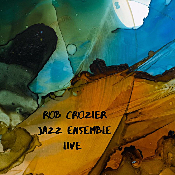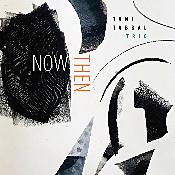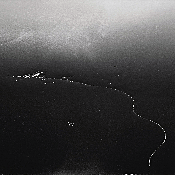Recent Recordings by Area Musicians
The SEMJA area is notable for the many fine jazz bassist combo leaders such as Ron Brooks, Marion Hayden, Rodney Whittaker, Paul Keller, and several others as well. Among the younger members of this select group, Rob Crozier has established himself as a hard-working instrumentalist and band leader, who was featured on a regular basis in venues throughout our area until the plague hit us. Rather than the ever-present jazz standards, Crozier’s quartet serves mostly as a vehicle for his own compositions, and these have been featured on several of his CD’s recorded in studio. His latest release is Rob Crozier Jazz Ensemble Live, which offers new versions of already recorded tunes, as well as two new ones, but this time taped during performances at the Dirty Dog Jazz Café in Grosse Pointe, one of the area’s premiere jazz clubs. He is joined by the regular members of his quartet, Rafael Statin on tenor and soprano saxophones, as well as bass clarinet, pianist and keyboard player Keaton Royer, and drummer Rob Avsharian, with the leader on acoustic and electric bass, mbira, and didgeridoo.
The CD is nicely paced, beginning with the funky laid back “H.O.M.E.S.,” built on electric piano and tenor saxophone riffs. Statin switches to soprano sax for the Trane-ish uptempo blues “R is for Richko,” dedicated to wonderful pianist Steve Richko, who left us much too soon, but while he clearly shows that he has studied his Coltrane, he has used this to develop his own saxophone voice, with a very different sound concept. Statin is an extroverted player, but no matter how exciting a solo might get, he carefully develops long lines and logically construed statements. The long opening saxophone solo on this track is a perfect example of his style, building long lines that slowly build tension and excitement; he exploits the full range of his horn, always in full command of each note, with a solid command of the intonation of this quirky saxophone. This is followed by a swinging, idiomatic solo by Royer, this time on acoustic piano. We are hearing a long club performance and so the drummer has his turn before the tune ends with the head. “Highway Hypnosis” provides a glimpse of Crozier’s love of more esoteric and atmospheric statements. The tune begins with the leader’s didgeridoo with Statin now on bass clarinet, moving into a swinging groove with a repetitive figure in the bass, that builds excitement as the reed man matches the rhythm section with trills and riffs of his own. Royer takes it down a bit with a contrasting solo that exploits the minor sonority that accelerates in intensity, eventually leading back to the full ensemble returning to the exotic tune.
Many of the compositions on this CD are built on vamps and strong rhythmic figures, but the sixth one, “Surrender,” recorded here for the first time, is a romantic ballad that provides a different vibe, leading to another great vamp, “Song for Kahil,” to round out the recital.
Crozier is a strong but subtle leader, who directs the band from his bass, programs well-conceived sets using his own compositions and has managed to keep his combo working steadily, and as a result this is a cohesive unit and not just a quartet of horn and rhythm section. The use of various instruments, most prominently Statin’s virtuosic use of a variety of horns, further enhances the sound of the unit. This CD, culled from three days of club performances in February of 2019, is the perfect showcase for one of the best working groups around.
Among expatriates from Detroit, drummer and percussionist Tani Tabbal holds a premier place. He grew up in Chicago, where he performed with Sun Ra at an early age and became involved with the Association for the Advancement of Creative Musicians (AACM). He eventually moved to Detroit, where he connected with musicians who were pursuing similar strategies, most prominently with A. Spencer Barefield, Anthony Holland, Farouk Z. Bey, joining the iconic Motor City group Griot Galaxy where he and bassist Jaribu Shahid created a splendid rhythm duo, an association that has lasted to this day and has anchored many different bands. Around 1990 he joined David Murray’s group and moved once again, this time to New York. He eventually moved still another time to the Hudson Valley, where he lives to this day, but he has remained close to his adopted Detroit roots, playing regularly with Shahid, James Carter, and other musicians from our area.
Tabbal has been featured on myriad recordings, beginning with Sun Ra, with Murray, Carter, Cassandra Wilson, Geri Allen, and many others, most often with AACM wizard Roscoe Mitchell, but also on some important recordings with Detroiters Holland and Barefield and, of course, with Griot Galaxy. Beginning with the 2007 Before Time, he began to release albums under his own name on his own label. His latest CD is Now Then on the recently formed Tao Forms label, featuring his long standing trio with alto saxophonist Adam Siegel and bassist Michael Bisio, which recorded two previous albums on the drummer’s own Tabbalia label. Of the ten tracks on this CD, six were composed by the leader and four by Bisio. This is also a long-standing working group and the three musicians have developed the kind of deep listening interaction that is crucial to this kind of improvised music. The sparse instrumentation creates an obvious challenge: how to create enough creative variety over more than an hour of music. Tabbal’s trio is more than successful in this matter, utilizing shifting, often extremely complex rhythms and a wide range of textures that exploit the full range of timbral and dynamic potentials of all three instruments. Tabbal has always been a sly, chameleon percussionist, teasing out myriad sounds from his drum set with a polyrhythmic concept that is equally at home in groove and swing as it is in out of tempo textural patterns. Bisio’s big sound and personal amalgam of melodic sensitivity and rhythmic drive offer a perfect match to the leader’s ever shifting propulsive playing. The younger Siegel in many ways has the hardest task here. Some may dispute this, but I have long maintained that the alto may be the hardest saxophone to play in an original manner: while there have been many who have developed individual sounds, among them Benny Carter, Johnny Hodges, Cannonball Adderley, Jackie McLean, or Ornette Coleman, there are many good players whose instrument “just sounds like an alto,” in the words of a great saxophone teacher. Siegel clearly belongs among those who have found a way to master the horn in a highly personal manner. Although obviously exposed in such a trio, Siegel fits in comfortably with his fellow musicians. He has an impressive technical command of the horn and his fleet sophisticated lines are apposite to the concept of the trio, enhanced by his use of a wide spectrum of timbres and various so-called extended techniques. Together, the three blend well, abolishing the traditional roles of each instrument, exploiting to the full the potential spectrum of interaction, from working fully in tandem to playing off or against each other, but ultimately creating an orchestral improvisational organism.
Each composition on Now Then establishes a different set of musical parameters, and it is often difficult to distinguish the boundaries between composition and improvisation, which is exactly what one wants in this kind of music.
Bassist and venue proprietor Joel Peterson and Sam Hooker of Peoples Records have teamed to create a new music label that has focused primarily on releasing vinyl albums, eclectic in musical style but “Detroit-centric.” Previous releases have been reviewed here and can be found on the SEMJA web page. Their newest offering, which is also available in CD and download formats, is an electro-acoustic recital entitled Scale by Zeena Parkins, acoustic and electric harp, forks/tuned metal, electronics, and field recordings and Jeff Kolar, electronics, radio, voice.
Parkins grew up in Detroit. Already a dancer and pianist, she discovered the harp in high school while studying at Cass Tech, moved on to Bard College and then on to a career in New York, collaborating with an unconventional array of artists, from John Zorn, Butch Morris, or Anthony Braxton to Yoko Ono and Björk. Herself a dancer and choreographer, she has created many scores for dance companies, but also worked with film and video makers. This particular work was originally composed together with the distinguished Chicago sound artist Jeff Kolar for a collaboration with dancer and choreographer Jennifer Monson.
Listening to Scale, one is immediately reminded of its dance origins—shifting sound patterns are often mixed with repetitive harp sections, with a broad array of sounds in background, some electronic, some indeterminate, some from disembodied human voices. The artistic goals of the authors are ambitious; as they perceived it, the project “addresses issues of observation, embodied transferences, telepathy and duration employing swipes, knocks, resonators and hypnotic patternings on the acoustic harp with the less controllable sounds of radio waves, homemade synths and feedback. Inspired by the timings and sensations of natural phenomena including daylight’s slow emergence at dawn and the pulsing ambiance of ocean currents. Nature as both utopic and disruptive.”
And it all works. There is mystery here, a form of abstract storytelling that superficially seems made up of random sounds but reveals itself to be intricately patterned and organized. The combination of various electronic sounds with the distinct use of the harp, sometimes fully acoustic, sometimes processed to various degrees, imposes a unique artistic stamp and while one can well imagine how it would be received very differently in tandem with dance movement, the music stands perfectly well on its own as the six tracks explore different sounds and emotions, sometimes looking back, sometimes moving forward, at other times seemingly suspended in time.


